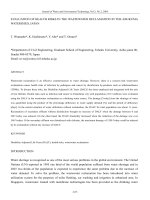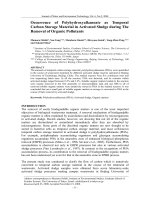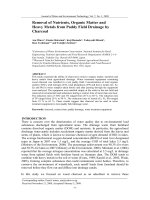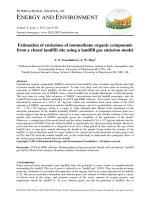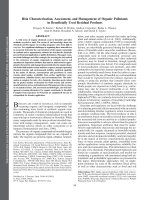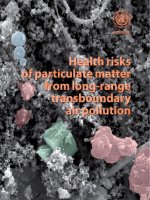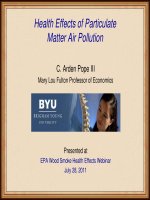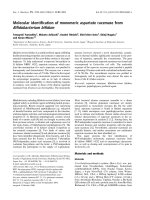HEALTH RISKS OF PERSISTENT ORGANIC POLLUTANTS FROM LONG-RANGE TRANSBOUNDARY AIR POLLUTION pptx
Bạn đang xem bản rút gọn của tài liệu. Xem và tải ngay bản đầy đủ của tài liệu tại đây (1.27 MB, 274 trang )
HEALTH RISKS
OF PERSISTENT
ORGANIC POLLUTANTS
FROM LONG-RANGE
TRANSBOUNDARY
AIR POLLUTION
Persistent organic pollutants (POPs) are organic compounds of
anthropogenic origin that resist degradation and accumulate in
the food-chain. They can be transported over long distances in the
atmosphere, resulting in widespread distribution across the earth,
including regions where they have never been used. Owing to their
toxicity, they can pose a threat to humans and the environment.
This publication, based on contributions from an international
group of experts, provides a concise review of the available evidence
on the characteristics of 13 groups of POPs (pentachlorophenol,
DDT, hexachlorocyclohexanes, hexachlorobenzene, heptachlor,
polychlorinated dibenzo-p-dioxins and dibenzofurans, polychlorinated
biphenyls, polycyclic aromatic hydrocarbons, polychlorinated terphenyls,
polybrominated diphenylethers, polybrominated dibenzo-p-dioxins and
dibenzofurans, short-chain chlorinated paraffins and ugilec). It reviews
pathways of human exposure related to the long-range transport of the
POPs through the atmosphere, and the potential hazards associated with
them. The review concludes with an expert assessment of the risks to
health associated with exposure due to the long-range transport of each
of the pollutants.
It is intended that the assessment will serve to strengthen the
commitment of the parties to the Convention on Long-range
Transboundary Air Pollution to improve air quality in Europe and to
prevent adverse effects of air pollution on human health.
E78963
HEALTH RISKS OF PERSISTENT ORGANIC POLLUTANTS
FROM LONG-RANGE TRANSBOUNDARY AIR POLLUTION
JOINT WHO/CONVENTION TASK FORCE ON THE HEALTH ASPECTS OF AIR POLLUTION
Language editing:
Frank Theakston
frank.theakston
@
get2net.dk
Layout and page make-up:
Sven Lund, mgk
svenlund
@
adr.dk
Printed in the Netherlands by
Drukkerij Wilco
HEALTH RISKS
OF PERSISTENT
ORGANIC POLLUTANTS
FROM LONG-RANGE
TRANSBOUNDARY
AIR POLLUTION
JOINT
WHO/CONVENTION
TASK FORCE
ON THE HEALTH
ASPECTS
OF AIR POLLUTION
Working Group Members:
Ruth Alcock, Vladimir Bashkin, Michèle Bisson,
R.W. Brecher, Leendert van Bree, Radovan Chrast,
Claudio Colosio, Hélène Desqueyroux, Elena
Evstafjeva,
Mark Feeley, Greg Filyk, Ramon Guardans,
Helen Hakansson, Thomas Hausmann, Ivan Holoubek,
Marek Jakubowski, Niklas Johansson,
Blanka Krauthacker, Michal Krzyzanowski,
Berit Kvaeven, Tamas Lotz, Alexander Malanichev,
Emilia Niciu, Nicolae Opopol, K. Phillips, Annick Pichard,
Irina Pichsheva, Theresa Repaso- Subang, Martin Schlabach,
Ion Shalaru, Stefan Seum, David Stone, Peter Straehl,
Lindita Tafaj, Carolyn Vickers.
Keywords
ENVIRONMENTAL POLLUTANTS
CHEMICALS - toxicity - adverse effects
ENVIRONMENTAL HEALTH
ENVIRONMENTAL EXPOSURE
RISK FACTORS
Address requests for copies of publications of the WHO Regional Office to ;
for permission to reproduce them to ; and for permission to translate them to
; or contact Publications, WHO Regional Office for Europe, Scherfigsvej 8, DK-2100
Copenhagen Ø, Denmark (tel.: +45 3917 1717; fax: +45 3917 1818; website: ).
© World Health Organization 2003
All rights reserved. The Regional Office for Europe of the World Health Organization welcomes requests for
permission to reproduce or translate its publications, in part or in full.
The designations employed and the presentation of the material in this publication do not imply the
expression of any opinion whatsoever on the part of the World Health Organization concerning the legal
status of any country, territory, city or area or of its authorities, or concerning the delimitation of its frontiers
or boundaries. Where the designation “country or area” appears in the headings of tables, it covers countries,
territories, cities, or areas. Dotted lines on maps represent approximate border lines for which there may not
yet be full agreement.
The mention of specific companies or of certain manufacturers’ products does not imply that they are
endorsed or recommended by the World Health Organization in preference to others of a similar nature
that are not mentioned. Errors and omissions excepted, the names of proprietary products are distinguished
by initial capital letters.
The World Health Organization does not warrant that the information contained in this publication
is complete and correct and shall not be liable for any damages incurred as a result of its use. The views
expressed by authors or editors do not necessarily represent the decisions or the stated policy of the World
Health Organization.
1.
2.
3.
4.
5.
6.
7.
8.
9.
10.
11.
12.
13.
Annex 1.
Annex 2.
Annex 3.
Abstract
Foreword
Abbreviations
Executive summary
Introduction
Pentachlorophenol
DDT
Hexachlorocyclohexanes
Hexachlorobenzene
Heptachlor
Dioxins and dioxin-like polychlorinated biphenyls
Polychlorinated biphenyls
Polycyclic aromatic hydrocarbons
Polychlorinated terphenyls
Polybrominated diphenyl ethers
Polybrominated dibenzo-p-dioxins and dibenzofurans
Short-chain chlorinated paraffins
Ugilec
Working Group members
Reviewers
Executive summary of the report prepared by the Joint
WHO/Convention Task Force on the Health Aspects
of Air Pollution
TABLE OF CONTENTS
vii
viii
x
xii
xiv
1
19
61
87
107
113
127
143
187
199
213
215
227
232
234
235
WHO Regional Office for Europe
Scherfigsvej 8,
DK-2100 Copenhagen Ø,
Denmark
Tel.: +45 39 17 17 17
Fax: +45 39 17 18 18
Website:
Persistent organic pollutants (POPs) are organic compounds of anthropogenic
origin that resist degradation and accumulate in the food-chain. They can be trans-
ported over long distances in the atmosphere, resulting in widespread distribution
across the earth, including regions where they have never been used. Owing to
their toxicity, they can pose a threat to humans and the environment.
This publication, based on contributions from an international group of experts,
provides a concise review of the available evidence on the characteristics of 13
groups of POPs (pentachlorophenol, DDT, hexachlorocyclohexanes, hexachlo-
robenzene, heptachlor, polychlorinated dibenzo-p-dioxins and dibenzofurans,
polychlorinated biphenyls, polycyclic aromatic hydrocarbons, polychlorinated ter-
phenyls, polybrominated diphenylethers, polybrominated dibenzo-p-dioxins and
dibenzofurans, short-chain chlorinated paraffins and ugilec). It reviews pathways
of human exposure related to the long-range transport of the POPs through the
atmosphere, and the potential hazards associated with them. The review concludes
with an expert assessment of the risks to health associated with exposure due to the
long-range transport of each of the pollutants.
It is intended that the assessment will serve to strengthen the commitment of the
parties to the Convention on Long-range Transboundary Air Pollution to improve
air quality in Europe and to prevent adverse effects of air pollution on human
health.
ABSTRACT
The long-range transport of air pollution has been recognized as an important
factor affecting ecosystems and human populations. The UNECE Convention on
Long-range Transboundary Air Pollution is a powerful international instrument
that aims to reduce and prevent air pollution. The effects of the Convention can be
assessed by the reduction in emissions of pollution by the countries that are Parties
to the Convention. However, an important criterion of the effectiveness of the
Convention is its ability to prevent or reduce the burden of long-range air pollu-
tion on the environment and human health.
The objective of the Protocol on Persistent Organic Pollutants to the Convention
is to control, reduce or eliminate discharges, emission and losses of persistent
organic pollutants (POPs). It is recognized that POPs resist degradation under
natural conditions and are associated with adverse effects on human health and
the environment. The Protocol describes the obligations of the Parties and, in par-
ticular, lists the substances that should be eliminated from production and use, or
for which use should be restricted. It also provides guidelines on the best available
techniques for controlling emissions of POPs.
Preventing health effects of POPs is a strong argument for the commitment of the
Parties to the Convention to ratifying and implementing the Protocol. However,
evidence of the role of long-range transport as a contributor to human exposure to
POPs and related health risks has been dispersed and not readily available. Therefore,
the Executive Body for the Convention, at its 17th Session held in Gothenburg on
29 November – 3 December 1999, requested the Joint WHO/Convention Task
Force on the Health Aspects of Air Pollution to review the relevant scientific infor-
mation and to provide the Convention with a concise, authoritative assessment.
The Task Force used existing reviews, such as the Environmental Health Criteria
documents published by the International Programme on Chemical Safety, the
WHO Air Quality Guidelines for Europe and other relevant publications, as
the basis for the health hazard assessment of selected POPs. It also used existing
information on the emission of POPs, their dispersal and levels in various environ-
mental media provided by the European monitoring programmes (in particular,
the Convention’s Cooperative Programme for Monitoring and Evaluation of the
Long-range Transmission of Air Pollutants in Europe, EMEP).
FOREWORD
Roberto Bertollini
Director
Division of Technical Support
– Health Determinants
WHO Regional Office for Europe
Copenhagen
Kaj Bärlund
Director
Environment and Human
Settlements Division
UNECE
Geneva
The report of the Task Force is based on contributions from its members, national
experts nominated by their governments or international experts invited by the
WHO European Centre for Environment and Health (ECEH). The WHO/
ECEH, Bonn Office, acted as the secretariat of the Task Force. We are most thank-
ful for all the expert contributions, and expect that the results presented in the
report will strengthen the commitment to improving air quality in Europe.
FOREWORD ix
Acceptable daily intake
Atmospheric Oxidation Program for Microsoft Windows
Agency for Toxic Substances and Disease Registry
Benzo[a]pyrene
Bioconcentration factor
Body weight
Convention on Long-range Transboundary Air Pollution
2,2-bis (p-chlorophenyl) acetic acid
1,1-dichloro-2,2-bis (4-chlorophenyl) ethane
1,1-dichloro-2,2-bis (4-chlorophenyl) ethylene
1,1,1-trichloro-2,2-bis (4-chlorophenyl) ethane
Cooperative Programme for Monitoring and Evaluation of the
Long-range Transmission of Air Pollutants in Europe
Hexachlorobenzene
Hexachlorocyclohexane
International Agency for Research on Cancer
Inhibiting concentration
Joint Meeting on Pesticide Residues
Organic carbon partition coefficient
Octanol/water partition coefficient
Lowest observed adverse effect level
Lowest observed effect level
Long-range transboundary air pollution
Meteorological Synthesizing Centre – East
Sodium pentachlorophenoate
No observed adverse effect level
No observed effect level
Polycyclic aromatic hydrocarbon(s)
Polybrominated dibenzo-p-dioxins
ABBREVIATIONS
ADI
AOPWIN
ATSDR
BaP
BCF
bw
CLRTAP
DDA
DDD
DDE
DDT
EMEP
HCB
HCH
IARC
IC
JMPR
K
oc
K
ow
LOAEL
LOEL
LRTAP
MSCE
NaPCP
NOAEL
NOEL
PAH(s)
PBDDs
PBDEs
PBDFs
PCBs
PCDDs
PCDFs
PCNs
PCP
PCTs
POPs
PTDI
SCCPs
TCBT(s)
TCDD
TDI
TEF
TEQ
TRI
UNECE
USEPA
Polybrominated diphenylethers
Polybrominated dibenzofurans
Polychlorinated biphenyls
Polychlorinated dibenzo-p-dioxins
Polychlorinated dibenzofurans
Polychlorinated naphthalenes
Pentachlorophenol
Polychlorinated terphenyls
Persistent organic pollutants
Provisional tolerable daily intake
Short-chain chlorinated paraffins
Tetrachlorobenzyltoluene(s)
2,3,7,8-tetrachlorodibenzo-p-dioxin
Tolerable daily intake
Toxic (TCDD) equivalency factor
Toxic equivalent
Toxic release inventory
United Nations Economic Commission for Europe
US Environmental Protection Agency
ABBREVIATIONS xi
EXECUTIVE SUMMARY
This report summarizes the results of the review of health risks of the persistent or-
ganic pollutants in relation to LRTAP performed by the Joint WHO/Convention
Task Force on the Health Aspects of Air Pollution. The process involved expert re-
view of accumulated evidence and a series of working group meetings, conducted
between May 2000 and May 2002. The risks associated with the following groups
of substances were reviewed: pentachlorophenol, DDT, hexachlorocyclohexanes,
hexachlorobenzene, heptachlor, polychlorinated dibenzo-p-dioxins and dibenzo-
furans, polychlorinated biphenyls and polycyclic aromatic hydrocarbons. The con-
clusions related to the health implications in relation to LRTAP for this group of
pollutants are summarized below. In addition, the Task Force performed a short
hazard assessment for polychlorinated terphenyls, polybrominated diphenylethers,
polybrominated dibenzo-p-dioxins and dibenzofurans, short-chain chlorinated
paraffins and ugilec, identifying the main gaps in information necessary for risk as-
sessment.
Pentachlorophenol / The health characterization of PCP indicates a potential
for a number of human health effects associated with low-level chronic exposure
via the oral route. Some of these effects have been seen as result of occupational
exposure. It is also known that man-made PCPs introduced into the environment
have the potential for long-range atmospheric transport, and may reach human
foodstuffs and drinking-water. Nevertheless, further research is needed to assess the
significance of LRTAP as a significant pathway leading to human exposure via the
oral route.
DDT / Intake through the diet may approach or even exceed the PTDI, particu-
larly in tropical and developing countries where DDT is still used for public health
purposes (or even used illegally). In these countries, local use represents the main
source of exposure. On the other hand, high levels of exposure also occur within
the LRTAP Convention area. These include the Inuit populations of Arctic re-
gions, where DDT has not been used for decades or has never been used. The main
source of exposure in this case, and the consequent health implications, are mainly
related to LRTAP.
EXECUTIVE SUMMARY xiii
Hexachlorocyclohexanes / Large reservoirs of HCH exist in the environ-
ment, which suggests that it potentially takes a long time for environmental levels
to reflect any action taken. Health hazard characterization has identified a range
of health effects related to exposure to γ-HCH by the oral route. Some might be
relevant to observed environmental exposures. The oral route is the most relevant
for LRTAP sources. Taking into account the uncertainties of the information, and
specifically the level of exposure at which human health can be affected, HCH may
be considered a possible risk to health through LRTAP.
Hexachlorobenzene / HCB is still released to the environment in the LRTAP
Convention region, mainly as a result of unintentional emission from waste
incineration and as a by-product of various manufacturing processes. Health
hazard characterization has identified a number of effects potentially related to
low-level chronic exposure via the oral route. Food is the most relevant means of
exposure related to LRTAP-derived sources.
Heptachlor / It appears that the general population is not at risk from LRTAP-
derived heptachlor, although highly exposed groups such as some breastfed infants
and Inuit in the Arctic may be at risk. Long-range transport represents the most
important source of heptachlor found in the terrestrial and aquatic food chains in
remote regions, although the environmental concentrations in those regions are
likely to be very low since contemporary use is limited.
Dioxins and dioxin-like polychlorinated biphenyls / As human ex-
posure levels often exceed the TDI, the weight of evidence suggests an increased
risk of harmful health effects in the general population, especially for breastfed
infants and populations with specific diets. Since the chemical and physical prop-
erties of PCDD/PCDFs and dioxin-like PCBs make them susceptible to LRTAP, it
is expected to contribute significantly to exposure and health risks.
Polychlorinated biphenyls / As human PCB exposure, including both
dioxin-like and non-dioxin-like congeners, may reach estimated LOAELs for neu-
rodevelopmental effects in infants, the weight of evidence suggests an increased
health risk from current exposures. Lack of congener-specific exposure and toxicity
data limits the possibilities for indicating which congeners are responsible for the
effects. Since the chemical and physical properties of PCBs make them susceptible
to LRTAP, they are expected to contribute significantly to exposure and health
risks, especially in remote areas.
Polycyclic aromatic hydrocarbons / The weight of evidence from epi-
demiological studies based on inhalation and occupational exposure to PAHs
suggests an increased risk of harmful health effects, mainly lung cancer. The excess
lifetime risk of lung cancer that can be attributed to LRTAP is low compared to the
risk due to exposure from local sources.
Persistent organic pollutants (POPs) are organic compounds of anthropogenic
origin that resist photolytic, biological or chemical degradation, leading to their
bioaccumulation in the food chain. They can be transported over long distances
in the atmosphere, resulting in widespread distribution across the earth including
regions where they have never been used. Owing to their toxic characteristics, they
can pose a threat to humans and the environment. In recent years, therefore, the
international community has called for urgent global action to reduce and elimi-
nate the release of POPs and to identify their possible risk to human health and the
environment.
The Protocol on POPs to the UNECE Convention on Long-range Trans-
boundary Air Pollution addresses several of those compounds, namely aldrin,
chlordane, chlordecone, DDT, dieldrin, endrin, heptachlor, hexabromobiphenyl,
hexachlorobenzene, hexachlorocyclohexanes, mirex, polyaromatic hydrocarbons,
polychlorinated biphenyls, polychlorinated dibenzodioxins and dibenzofurans,
and toxaphene. The Protocol describes the technical measures required to elimi-
nate or restrict the production or use of these substances, and identifies the require-
ments to achieve that goal.
It is the objective of the Protocol to prevent adverse effects on human health or
the environment. Therefore, the Executive Body for the Convention, at its sev-
enteenth session held in Gothenburg in November/December 1999, requested
the Joint WHO/UNECE Task Force on Health Aspects of LRTAP to provide a
preliminary selection of priority POPs based on the assessment of potential health
effects and on the potential contribution of long-range transport to population ex-
posure and risk. Following this request the Task Force, at its meeting in May 2000,
selected the following groups of substances for which the risk assessment would be
conducted:
pentachlorophenol, DDT, hexachlorocyclohexanes, hexachlorobenzene,
heptachlor, polychlorinated dibenzo-p-dioxins and dibenzofurans,
polychlorinated biphenyls and polycyclic aromatic hydrocarbons (UNECE
2000). In addition, a short hazard assessment was planned for polychlorinated
terphenyls, polybrominated diphenylethers, polybrominated dibenzo-p-
dioxins and dibenzofurans, short-chain chlorinated paraffins and ugilec.
This document presents the results of the evaluation requested by the Executive
Body, as well as the background material for this evaluation. It was prepared by an
international group of experts listed in Annex 1. The experts were invited based
INTRODUCTION
on their known expertise as well as on the recommendations of the Parties to the
Convention. Besides the experts drafting various parts of the text and participating
in working group meetings, a group of external reviewers contributed comments
on the drafts (see Annex 2).
THE PROCESS
First drafts of the background papers were reviewed at the fourth meeting of
the Task Force on Health Aspects of LRTAP, held in Bonn, Germany, on 3–4
December 2001. Following the recommendations of the meeting, the Expert
Group designated by the fourth meeting of the Task Force prepared a draft report
entitled “Health risks of POPs from LRTAP”. Comments on this draft were re-
ceived both from members of the Expert Group and external reviewers. A small
drafting group, meeting on 26 April 2002, proposed a uniform format of the re-
view for each group of substances.
To finalize the assessment, the fifth meeting of the Task Force was convened in
Bonn on 13–14 May 2002. The meeting reviewed the drafts, taking into account
the comments received from the reviewers. The meeting prepared and approved
executive summaries for all the substances reviewed, except ugilec. These summa-
ries were presented to the Working Group on Effects for approval at its 21st Session
on 28–30 August 2002 (UNECE 2002) and are also included in this document
as Annex 3. The staff of the WHO European Centre for Environment and Health
in Bonn, in close collaboration with the main authors of the chapters, carried out
the final editing of the background material presented in the individual chapters of
this document.
Evaluation of the health risks related to LRTAP for ugilec was not possible
because of the incompleteness of the relevant information. The information col-
lected by the Expert Group on this group of substances is, however, presented in
this report.
The present assessment conducted by the Task Force is complementary to the
work of the ad hoc group of experts on POPs under the LRTAP Convention.
This group is reviewing the existing obligations on substances already in the 1998
UNECE/LRTAP Protocol on POPs and is advising national experts preparing
preliminary risk profiles on substances that may be candidates for inclusion in the
Protocol.
STRUCTURE OF THE REPORT
To assess the risk to human health related to long-range transport of the considered
pollutants, the experts considered the ability of substances to be transported in
the environment over long distances after their release to the environment, their
potential to persist and accumulate in different environmental compartments, the
pathways and opportunities for human exposure to the substance transmitted in
the environment, and data characterizing the hazardousness of the substance. The
discussion of the experts during the working group meetings concentrated on for-
mulating the conclusions of the assessment. In the result, the assessment of each of
INTRODUCTION xv
the substances or group of substances described in this document is presented in
the following sections.
•
Introduction (summarizing the sources and uses of the substance, as well as its
status in the POPs Protocol).
•
Characteristics of the substance(s)
1
as compound(s) with long-range
transboundary potential (listing its/their chemical and physical properties,
assessments of its/their concentrations in environmental media and ability to
bioaccumulate).
•
Pathways of human exposure and its relation to LRTAP, using results of
available exposure assessment studies and models.
•
Health hazard characterization based on existing toxicological (human and
animal) data as well as, where available, epidemiological information. This
section also includes the results of risk assessment performed by WHO, IARC
or major national chemical safety and public health agencies and the relevant
reference values.
•
Human health implications relative to LRTAP, summarizing the evidence
presented in earlier sections and providing conclusions of the assessment.
Assessing concentrations of POPs in the atmosphere and their environmental fate
relies also on modelling. Several groups, using various methods over the past two
decades, have attempted numerical modelling of long-range atmospheric trans-
port of persistent organic pollutants. Several approaches have been used, which
can be grouped in two broad types: generic box models based on the fugacity con-
Fig. 1. Simplified scheme of the EMEP/MSCE POPs model
INTRODUCTIONxvi
1
The plural is used for compounds whose chemical name implies a number of isomers or congeners.
ATMOSPHERE
D
E
G
R
A
D
A
T
I
O
N
O
U
T
G
R
I
D
VEGETATION
SOIL
SEA
EMISSIONS
cept (e.g. Mackay & Wania 1995; Wania & Mackay 1999) and dynamic transport
models (Strukov et al. 2000).
Fig. 1 presents a simplified scheme of the EMEP/MSCE POPs model. It is a
multi-compartment model with Eulerian-type advection scheme with spatial reso-
lution 150 × 150 and 50 × 50 km. It includes the atmosphere, soil, sea water and
vegetation. The model is able to assess the redistribution of POPs between these
media and estimate concentration levels in them. Obviously, many uncertainties
remain concerning, for instance, emission rates, degradation rates and the role of
sediments. Results obtained from this model, or models similar to it, are used in
various parts of this report for illustrative purposes as, despite their limitations,
they do indicate the main features of large-scale atmospheric transport.
REFERENCES
Mackay, D. & Wania, F. (1995) Transport of contaminants to the Arctic:
partitioning, processes and models. Science of the total environment,
160/161: 25–38.
Strukov, B. et al. (2000) Modelling long-range transport and deposition of POPs in
the European region with emphasis to sea currents. Moscow, EMEP Meteorological
Synthesizing Centre – East (Report 5/2000).
UNECE (2000)
/>UNECE (2002)
/>Wania, F. & Mackay, D. (1996) Tracking the distribution of persistent organic
pollutants. Environmental science and technology, 30: A390–A396.
Wania, F. & Mackay, D. (1999) Global chemical fate of a-
hexachlorocyclohexane.2. Use of a global distribution model for mass balancing,
source apportionment, and trend prediction. Environmental toxicology and
chemistry, 18: 1400–1407.
INTRODUCTION xvii
CHAPTER 1/
PENTACHLOROPHENOL
1/ INTRODUCTION
Pentachlorophenol (PCP) is a white organic solid with needle-like crystals and a
phenolic odour. It may be released to the environment as a result of its manufac-
ture, storage, transport or use. One major use of PCP is as a wood preservative,
primarily applied to protect timber from fungal rot and wood-boring insects, but it
has also been used as a pre-harvest defoliant in cotton, as a general pre-emergence
herbicide, and as a biocide in industrial water systems. Its sodium salt is used for
similar purposes and readily degrades to PCP. At present, the most extensive use
of PCP is the production of the ester, pentachlorophenyl laurate (PCPL), which is
less toxic by an order of magnitude.
Production of PCP and sodium pentachlorophenate (NaPCP) ceased in the
European Union in 1992, since when they have been imported to the European
market from the United States. There is unconfirmed information that additional
NaPCP may be imported from South-East Asia (EC 1998; OSPAR 2001). In 1996,
a total of 378 tonnes of NaPCP and 30 tonnes of PCP were imported into the
European Union (France, Portugal, Spain and the United Kingdom). Imported PCP
is manufactured into PCPL in the United Kingdom (EC 1998; OSPAR 2001).
PCP has been one of the most heavily used pesticides in the United States:
42 million pounds in 1984; 38 million pounds in 1985; 32 million pounds in
1986 and 18.2 million pounds (9.1 thousand short tons) in 1996. About 24 mil-
lion pounds were manufactured in 1987 by Vulcan Materials. More recent pro-
duction data are not available (ATSDR 2001).
According to the TRI, an estimated 13 141 pounds of PCP, amounting to 54%
of the total environmental release, was discharged to the atmosphere from manu-
facturing and processing facilities in the United States in 1991 (ATSDR 2001).
The TRI data should be used with caution because only certain types of facility are
required to report; the list of facilities is not exhaustive (ATSDR 2001).
PCP can be formed during the incineration of chlorine-containing waste mate-
rial. Heeb et al. (1995) found that PCP constituted 8% of polychlorinated phe-
nols formed in the flue gas and 10% of those formed in the stack gas during the
incineration of chlorine-containing waste material. It may also be released in stack
emissions as a result of pyrolysis of polyvinyl chlorides (Blankenship et al. 1994).
Available measurements and calculations show that, for the period 1980–1996,
about 37 tonnes of PCP per year are released from a municipal waste incinerator in
Hungary (Kovács 2002).
Technical grade PCP has historically contained dioxins (e.g. tetra-, hexa- and
octochlorodibenzo-p-dioxins) and hexachlorobenzene as manufacturing by-prod-
ucts. Technical grade PCP is typically about 86% pure.
PCP is a major product of the metabolism of hexachlorobenzene in mammals.
Actions on PCP are not included in the 1998 UNECE/LRTAP Protocol on
POPs. However, PCP is identified in article 8 concerning research development,
monitoring and cooperation. Hence PCP is one of the substances considered to be
the most likely to be added to the annexes of the Protocol.
2/ POTENTIAL FOR LRTAP
2.1/ Physical properties allowing atmospheric transport
Fig. 1.1. Pentachlorophenol
(C
6
HCl
5
O),
CAS registry: 87-86-5
Fig. 1.2. Sodium
pentachlorophenate (C
6
Cl
5
ONa),
CAS registry: 131-52-2
The physical and chemical properties of the compound suggest limited evapora-
tion to the atmosphere and that most of it will move with water and generally as-
sociate with soil particles. Movement of PCP in soils depends on soil acidity.
Property
Molecular weight
Solubility in water
Log K
ow
Log K
oc
Vapour pressure at 25 °C
Henry’s law constant at 25 °C
PCP
266.35
14 mg/l at 20 °C
3.32
4.5
0.00011 mmHg
3.4 x 10
–6
atm·m
3
/mol
NaPCP
288.34
330 000 mg/l at 25 °C
No data
No data
No data
No data
Table 1.1. Physical properties of PCP and NaPCP
2.2/ Persistence in water, soil and sediment
The photolysis of PCP in water is a significant process largely dependent on the
pH. The ionized form is more sensitive to photodegradation than the protonated
form. Weiss (1982) showed 90% degradation in 10 hours of PCP in surface water
with a pH of 7.3, while at pH 3 the degradation was only 40% after 90 hours.
Photolysis in water leads to the formation of substances such as 2,3-dichloromaleic
acid, 2,3,5,6- and 2,3,4,6-tetrachlorophenol, tetrachlororesorcinol, tetrachloro-
catechol, benzoquinones and potentially dioxins.
CHAPTER 12
Sources: ATDSR; Montgomery 1996.
Cl
Cl
Cl
Cl
Cl
OH
Cl
Cl
Cl
Cl
Cl
O
–
Na
+
In wet soil, photolysis may be significant (Donaldson & Miller 1997). These
authors showed 55% photodegradation of PCP added to a sandy clay loam soil
over a 14-day period.
Increasing concentration tends to lengthen the process of biodegradation, prob-
ably owing to the possible toxicity of PCP for bacterial colonies. Maximum rates
of degradation of 0.3–0.5 mg/kg per day in soils containing 30 mg/kg PCP and
a degradation rate of 82% after 7 months have been reported by Miethling &
Karlson (1996). Over the same period, less than 2% of the PCP added to the soil in
a concentration of 100 mg/kg had degraded.
PCP released into the atmosphere from treated wood can be transported back
to surface waters and soils via wet and dry deposition. Atmospheric PCP is trans-
formed via photolysis; the compound may slowly undergo free radical oxidation
with an estimated half-life of approximately 2 months (ATSDR 2001).
Atmospheric PCP probably undergoes photolysis in the absence of water, al-
though mechanisms for this reaction are not well known (Crosby & Hamadad,
1971; Gäb et al. 1975). Photolysis of sorbed or film-state PCP in the presence of
oxygen has also been observed (Gäb et al. 1975). The reaction products were simi-
lar to those found in aqueous photolysis. Bunce & Nakai (1989) estimated the rate
of photolysis in the atmosphere based on measured quantum yields (254 nm) in
the laboratory, molar absorptivity values and solar intensity values for mid-day in
summer at a latitude of 40° N; the estimated loss of PCP to vapour-phase photoly-
sis was 6.2% per hour. This rate represents the maximum rate at 40° N; the average
rate of photolysis for PCP will be lower. No empirical data were found describing
the reactivity of PCP to free radical oxidation in the atmosphere. Bunce & Nakai
(1989) calculated the potential atmospheric degradation of PCP due to hydroxyl
radical attack. The estimated loss rate was 1.5% per hour (half-life of 66 hours) as
calculated from an estimated rate constant of 4.7 × 10
–13
cm
3
· molec
–1
· s
–1
, assum-
ing a peak noon summer hydroxyl radical concentration of 6.2 × 10
6
molec/cm
3
(ATSDR 2001).
Using the method of Meylan & Howard (1993), a half-life of 58 days for the
vapour-phase reaction of PCP with hydroxyl radicals can be obtained from an esti-
mated rate constant of 5.5 × 10
–12
cm
3
· molec
–1
· s
–1
and an average hydroxyl radical
concentration of 5.5 × 10
5
molec/cm
3
. Adsorption of PCP to particulate matter
will, however, attenuate the rate of this process in the atmosphere (ATSDR 2001).
Volatilization from treated wood poles and other outdoor-use wood also occurs.
Between 30% and 80% of the PCP applied to coniferous wood by dip or brush
treatments may be lost by volatilization within 12 months (Bunce & Nakai 1989).
Ingram et al. (1986) reported increased volatilization of PCP from treated wood
with increased temperature; similar results with temperature change were seen
with each of numerous solvent systems used to apply the compound.
2.3/ Bioaccumulation
The bioconcentration of PCP in aquatic organisms is high. Bioconcentration fac-
tors of 100–1000 have been reported by a number of authors (Bude et al. 1985;
PENTACHLOROPHENOL 3
Devillers et al. 1996; Lu & Metcalf 1975; Parrish et al. 1978). The bioconcen-
tration depends on the pH and increases with falling pH (Kobayashi & Kishino
1980).
The toxicity is also largely dependent on the pH of the matrix tested. The acute
toxicity of PCP was investigated at pH 4, 6 and 9 in Chironomus riparius; this
experiment showed that toxicity was maximum at pH 4 and minimum at pH
9. The difference in toxicity was attributed to variations in the degree to which
the substance penetrated the organism tested, since at pH 4 the PCP is entirely
in protonated form and therefore lipophilic. Conversely, at pH 9 PCP is fully
ionized, which reduces the potential for penetration into the organism, and at the
same time reduces the potential for build-up and toxic effects (Fisher & Wadleigh
1986).
No reliable data have been found for the bioaccumulation of PCP in plants.
2.4/ Monitoring and modelling
Limited information is available on the levels of PCP in ambient air. USEPA
(1980) estimated atmospheric concentrations of PCP using air models. A cumula-
tive concentration estimate based on all emission sources was 0.5–136 ng/m
3
. The
lower end of this range coincides with the upper end of the range of computed
air concentration estimates based on PCP concentrations in rainwater in Hawaii
(0.002–0.063 ng/m
3
), where PCP has been used extensively as an herbicide and
wood preservative. A Canadian study (Cessna et al. 1997) reported the amount
of PCP in air in Saskatchewan (Regina and Waskesiu) and Northwest Territories
(Yellowknife). The concentrations of PCP in the vicinity of Yellowknife ranged
from 0.43 to 3.68 ng/m
3
with a mean concentration of 1.53 ng/m
3
. At both the
Regina and Waskesiu sites, the concentrations ranged from 0.06 to 0.58 ng/m
3
with a mean value of 0.30 ng/m
3
(ATSDR 2001)
Two background air sampling stations in the mountains above La Paz, Bolivia,
at 5200 m measured 0.93 and 0.25 µg PCP per 1000 m
3
of air, and four Antwerp
(Belgium) samples varied from 5.7 to 7.8 µg PCP per 1000 m
3
of air. The level of
PCP in Burlington, Ontario, rainwater was 10 µg/l in 1982 (Warrington 1996).
In the past, PCP concentrations as high as 25 000–150 000 µg/l in industrial ef-
fluent were reported; at one time, 30–40 tonnes were calculated to be transported
by the Rhine each year (WHO 1998). Concentrations up to 10 500 µg/l have been
reported locally in a river (Fountaine et al. 1976), but concentrations in water sam-
ples are usually below 10 µg/l (WHO 1987). Monitoring data showed that PCP
concentrations generally decreased (from 0.07–0.14 µg/l in 1988 to 0.01–0.02
µg/l in 1993) in the River Elbe after PCP production was stopped in Germany
in 1986 and its use was banned in 1989. Such a trend was not seen in the Rhine
and its tributaries, where concentrations were even higher in 1990–1991 than in
1980–1989 (maximum levels up to 0.23 µg/l); the cause is not known, but it indi-
cates continuing environmental contamination.
Concerning measurements in biota as evidence of transport to remote regions,
the situation is complicated for two main reasons. On the one hand, PCP is me-
CHAPTER 14
tabolized into other molecules and therefore its absence in animal tissues is not
conclusive; on the other hand, it is a major product of the metabolism of hexachlo-
robenzene and other common pesticides in mammals, and therefore if it is found it
does not mean it was taken up as such.
Fig. 1.3 and 1.4 present pilot calculations of PCP transport from Hungarian
and United Kingdom emission sources (Shatalov et al. 2002). PCP emissions are
adapted from Berdowski et al. 1997. From these figures it can be seen that PCP is
capable of being transported over considerable distances.
Fig. 1.3. Spatial
distribution
of PCP air
concentrations
(ng/m
3
) from
Hungarian
emission
sources for 1990
(Berdowski
et al. 1997).
Violet means
concentrations
less than the
0.003 ng/m
3
threshold level
(Shatalov et al.
2002).
Fig. 1.4. Spatial
distribution
of PCP air
concentrations
(ng/m
3
) from
United Kingdom
emission
sources for 1990
(Berdowski
et al. 1997).
Violet means
concentrations
less than the
0.005 ng/m
3
threshold level.
2.5/ Conclusions regarding the LRTAP potential
The physical and chemical properties of the compound suggest limited evaporation
to the atmosphere and that most of it will move with water and generally associate
with soil particles. The mobility and availability of PCP in the environment
depends on the acidity of the medium. The volatilization of PCP from treated
PENTACHLOROPHENOL 5
threshold level 0.003
threshold level 0.005
